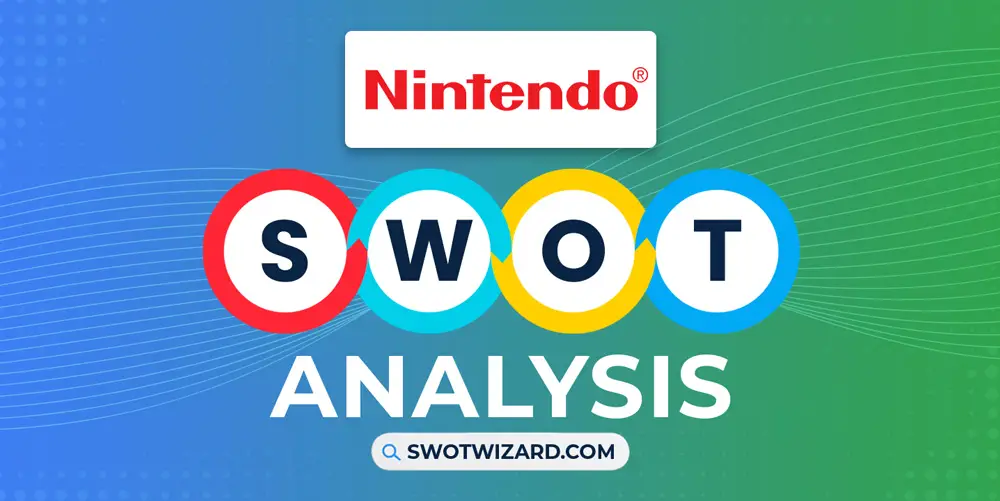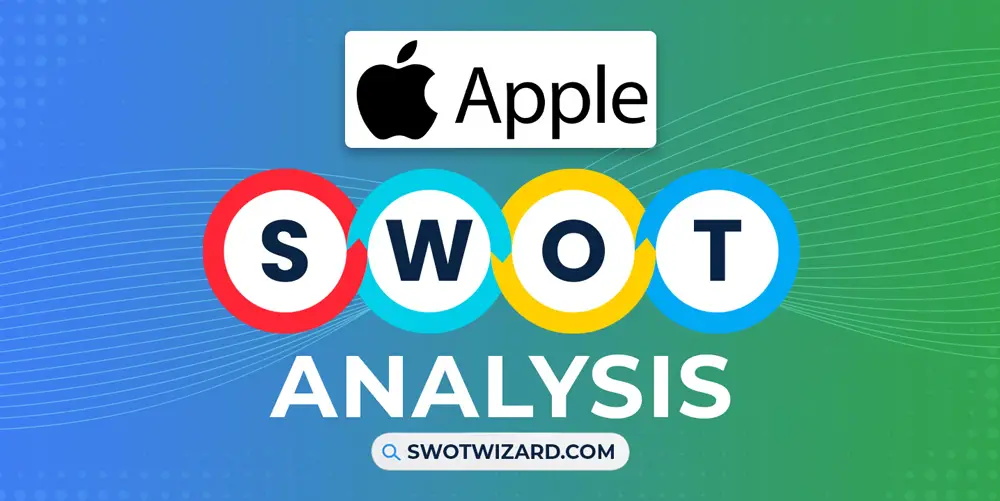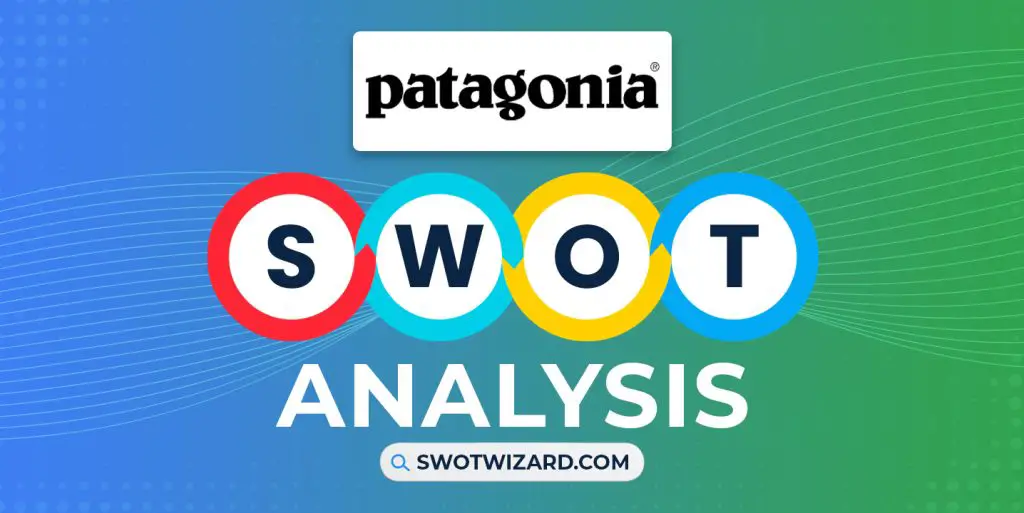Nintendo is one of those toys which kids grow up with. In your entire life, you have seen or played Nintendo video games, even after the smartphone revolution came.
Nintendo is over a hundred years old and still coming with new offerings in the market and going strong. We will learn more about Nintendo and its strengths, weaknesses, opportunities, and threats in this Nintendo SWOT analysis.
Nintendo: Company Overview
| Company | Nintendo Co. Ltd. |
| Industry | Video Games |
| Founded | 23 September, 1889 |
| Founder | Fusajiro Yamauchi |
| President | Shuntaro Furukawa |
| Headquarter | Minami-ku, Kyoto, Japan |
| No. of Employees | 7,317+ |
| Annual Revenue | $13.923 billion (FY 2023) |
| Website | nintendo.com |
About 133 years ago, a humble playing card company named Nintendo laid its foundation in the bustling city of Kyoto, Japan. Over the years, Nintendo’s visionary leaders and creative minds embarked on a quest to revolutionize entertainment, ultimately shaping the landscape of the gaming industry.
Fast forward to the present day, Nintendo stands as a titan in the gaming industry, with a fascinating company overview. In 2022, the company had a total revenue of $15.089B, with only 6,717 people helping to create beautiful games and bring smiles and laughter to every household.
Product & Services of Nintendo
Game Consoles | Toys and Cards | Nintendo Switch | Home Consoles | Wii | Handhelds | Mobile devices | Hardware | E-shop
Nintendo Competitors
Sony | Microsoft | Sega | Atari | Bandai Namco | Capcom | Konami | Square Enix | Ubisoft | EA
Did You Know?
Nintendo has been home to legendary game designers like Shigeru Miyamoto, creator of iconic franchises like Super Mario, The Legend of Zelda, and Donkey Kong, and Masahiro Sakurai, the mind behind the Super Smash Bros. series.
Strengths – Nintendo SWOT Analysis

High Brand Value: The company boasts a strong brand image built over decades, synonymous with quality and innovation. The Nintendo brand evokes a sense of nostalgia and trust among consumers, driving sales and customer loyalty. The Super Mario franchise has become an iconic gaming symbol, contributing to the brand’s enduring popularity.
Global Network: With a vast global network of subsidiaries, Nintendo has established a strong presence in major markets worldwide. Nintendo of America, Nintendo of Europe, and Nintendo of Japan facilitate effective distribution and marketing strategies tailored to regional preferences. As a result, it gives the company a global reach and allows Nintendo to capitalize on diverse markets and maintain a wide customer base.
Product Variety: In the company’s long history, Nintendo has created tons of products, starting with consoles, handheld devices, software lineups, etc. From the family-friendly Nintendo Switch, offering versatility between handheld and home console play, to portable systems like the Nintendo 3DS, the company caters to a broad spectrum of gaming preferences, appealing to different demographics and expanding its market share.
Strategic Partnerships: Nintendo has formed partnerships to enhance its product offerings and expand its reach. The collaboration with The Pokémon Company has resulted in the wildly successful Pokémon franchise, generating substantial revenue through video games, merchandise, and media. And recently, the company has partnered with Microsoft and Nvidia to win the Activision Blizzard deal.
Weaknesses – Nintendo SWOT Analysis
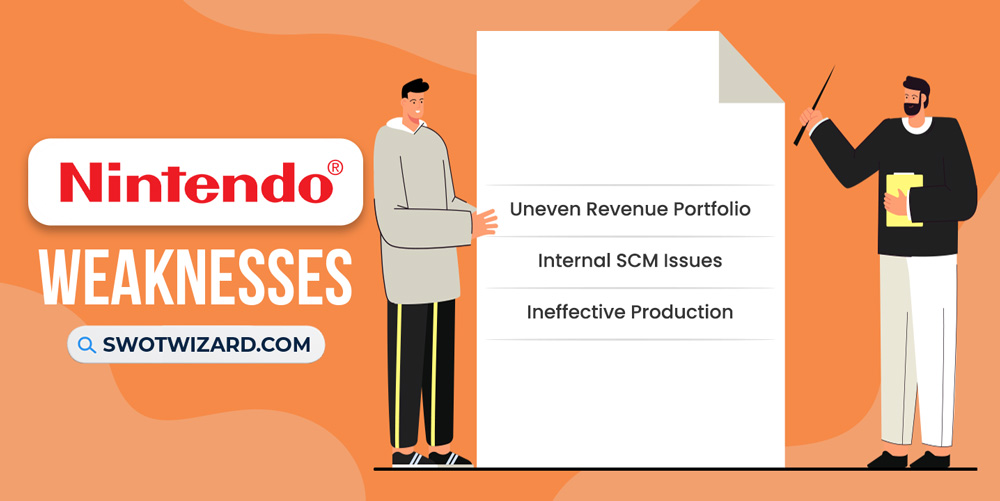
Uneven Revenue Portfolio: The company heavily relies on its first-party titles and franchises, such as Mario and Zelda, for revenue generation. Everything is fine, but it creates a potential risk if a game underperforms or fails to meet expectations, as one of the incidents happened a few years ago, where the Wii U console’s lackluster sales were partially attributed to a limited lineup of compelling games, resulting in a revenue decline.
Internal SCM Issues: As the core products are hardware, they heavily rely on different parts internally and externally. As a result, the company ended up with product shortages and frustrated customers because of internal challenges in managing its supply chain. Nintendo Switch witnessed supply constraints, causing demand-supply imbalances and missed sales opportunities, potentially impacting customer satisfaction and market share.
Ineffective Production: As an experienced and old company, they should have been better at production planning, but it seems Nintendo has experienced difficulties in accurately forecasting demand and aligning production accordingly. Consequently, it has led to instances where the company has been unable to meet the high demand for its products, such as the scarcity of the NES Classic Edition and SNES Classic Edition consoles, creating frustration among consumers seeking to purchase them.
Opportunities – Nintendo SWOT Analysis

Market Expansion: The company has the opportunity to expand its market reach by targeting emerging markets or untapped demographics. Entering markets with a growing gaming culture, like India, could lead to significant sales growth. Besides, targeting older demographics and casual gamers through marketing campaigns and tailored game offerings could open new revenue streams.
Diversified Offerings: The company has made itself a big name that is also a name for nostalgia for many people. Nintendo can expand its offerings beyond games. Expanding into merchandise, such as clothing, toys, and collectibles, can create additional revenue streams and strengthen brand loyalty.
Adopt VR Tech: Apple recently launched its VR, and many companies are working on it. It is high time, and embracing Virtual Reality (VR) technology presents an opportunity for Nintendo to enhance the gaming experience and tap into a growing market. Developing VR-compatible games or accessories for the Nintendo Switch could attract tech-savvy consumers and differentiate Nintendo’s offerings from competitors.
Strategic Acquisition: The world is moving fast, and there are tons of things to work on and opportunities to grab, and Nintendo can’t do everything on its own. That’s why they have the opportunity to strategically acquire companies or studios to strengthen their game development capabilities or expand into new genres. Acquiring a studio known for creating immersive open-world games could enable Nintendo to diversify its portfolio and cater to gamers seeking more extensive and realistic experiences.
Threats – Nintendo SWOT Analysis

Competitive Market: Nintendo faces fierce competition from other gaming console manufacturers like Sony (PlayStation) and Microsoft (Xbox). The intense rivalry requires Nintendo to continually innovate and offer unique gaming experiences to maintain its market share.
Counterfeit Products: The popularity of Nintendo’s consoles and games has led to a significant issue of counterfeit products. Counterfeiters produce fake Nintendo consoles, games, and accessories, resulting in lost revenue and potential damage to the brand’s reputation. As a result, counterfeit Nintendo Switch consoles flooded the market, often lacking quality control and leading to dissatisfied customers.
Alternative Options: The rise of alternative gaming platforms threatens Nintendo, and mobile gaming on smartphones and tablets has gained popularity, offering convenient and affordable gaming experiences. With a vast array of games and the convenience of app stores, mobile gaming competes directly with Nintendo’s handheld and console offerings.
Supply Chain Disruptions: Nintendo relies on a complex global supply chain to produce its consoles and accessories. Disruptions like natural disasters, trade disputes, or logistical challenges can lead to component shortages, production delays, losing revenue, and increased costs. And recent war, dollar crisis, and raw material issues have been causing issues in the supply chain.
[Bonus Infographic] SWOT Analysis of Nintendo
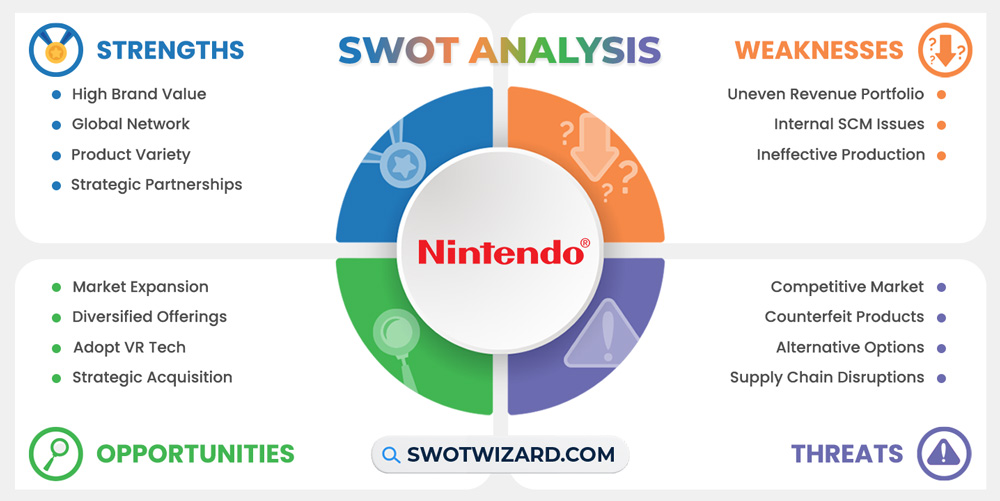
Recommendations for Nintendo
The gaming world is changing fast, and so is the competition. To survive another hundred years, Nintendo needs to plan the future strategically.
- Explore opportunities in emerging markets to tap into growing gaming cultures and capture new audiences.
- Extend merchandise offerings beyond gaming, such as clothing and collectibles, to leverage popular franchises and boost revenue streams.
- Embrace Virtual Reality to enhance gameplay experiences and attract tech-savvy consumers, leveraging Nintendo’s creative gameplay and beloved characters.
- Consider acquiring studios to strengthen game development capabilities and expand into new genres, enhancing portfolio diversity.
- Implement robust supply chain management strategies to address potential disruptions and ensure consistent product availability in the market.
Frequently Asked Questions (FAQs)
Which Nintendo Was The Most Popular?
Nintendo DS was the most popular.
What Was The Last Nintendo Game Made?
The Lion King was the last Nintendo game made.
Final Words on Nintendo SWOT Analysis
Nintendo is a legendary force in the gaming industry driven by innovation, iconic franchises, and a commitment to creating joyous experiences. With its rich history, strategic opportunities, and ability to captivate audiences, Nintendo continues to shape the future of gaming, delighting players worldwide.
References
- Wikipedia contributors. (n.d.). Nintendo. Wikipedia.
- Haider, A. (2023, March 24). Super Mario Bros: The ultimate video game icon. BBC Culture.
- Gibson, D. (2022, February 23). How Nintendo became ‘the Disney of gaming’ through ruthless consistency of brand. The Drum.
- Sejwal, R. (2022). Recent Rumors Surface Nintendo Might Be Working on a VR Device for Switch 2. EssentiallySports.
- Trovall, E. (2022, January 7). Thousands of counterfeit AirPods, Nintendo consoles seized at Houston port. Houston Chronicle.

